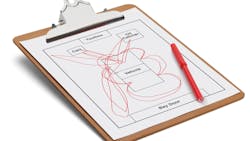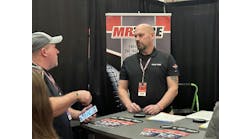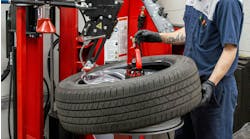If you’re a store owner or manager, I would like to give you a homework assignment. Take out a clipboard, pen and paper and go out to your shop. Label one side of the piece of paper “bay door” and note some important pieces of equipment, like a toolbox or cart.
Now wait for an oil change job to come through the bay door. Trace the steps your technician takes throughout the entire process of the oil change — every movement. What you will have after the vehicle is pulled out will look like spaghetti.
If you do this once, it may show you the great amount of inefficiency — including wasted time and steps — in your oil change process. If you do it a second time, for the next oil change, and the spaghetti looks different, you have a bigger problem: you have no process.
Let’s tackle the first problem.
Having an inefficient process wastes time. We all know the feeling, usually around 10 a.m. or 11 a.m., where we seem to get “backed up” with waiting customers. Service advisors start to get concerned. And when the phone rings, the stated wait time for a simple service like an oil change starts to get longer. The same goes for tire rotations.
At this point, you are likely losing out on service for that day. The customer will then call around, looking for a shop that will quote a more acceptable time frame.
If you find yourself in this situation, I’d like you to do the unthinkable: give an oil change to your top technician. And do the diagram again. It likely won’t look like spaghetti this time. There will be fewer lines.
A seasoned technician knows about something the French call “mise en place.” It means “everything organized before starting the work.” In other words, you think about the tools and steps you are going to have to use and follow before you begin.
It also means having the necessary equipment or supplies close at hand, like oil catchers and filters.
When a technician prepares his or her workspace prior to getting the work done, it almost always gets done faster, more efficiently and with fewer mistakes.
Now, onto the second problem: the two different pieces of spaghetti. This means your shop has no process. Not only is this inefficient, but it’s also a liability.
In this scenario, a seasoned technician also always does an oil change the exact same way, every time. Why? So they don’t have to think about what’s next.
The same principle can be applied to a tire rotation. Does every technician start and end on the driver’s front tire? That’s the tire that can cause the most damage in the event of a wheel-off.
Lack of process often isn’t the technician’s fault. They either were never taught an official way to perform an oil change or tire rotation at your location or they’ve drifted from the process and have been allowed to do it differently for quite some time.
Remember that your least-tenured, least-paid employee is handling some of the most expensive items to fix if there is a mistake. Generally speaking, if your top technician makes a mistake, you have to replace a part. When the general service person makes a mistake, it gets more expensive.
I also advise you to involve your best technicians in coming up with written procedures. You don’t have to list every little step. But the major milestones in the oil change, for example, should be written out so that a newer technician knows how to do the job properly. (You can even make it a point of pride and show your customers what they are buying.)
Doing an oil change or replacing a tire isn’t the same as it was 15 or 20 years ago. These jobs are much more complicated and if a mistake is made, much more costly to fix. After you create your dealership’s standard operating procedure, make sure your technicians learn it. And make sure you spot-check their adherence to it from time to time.





